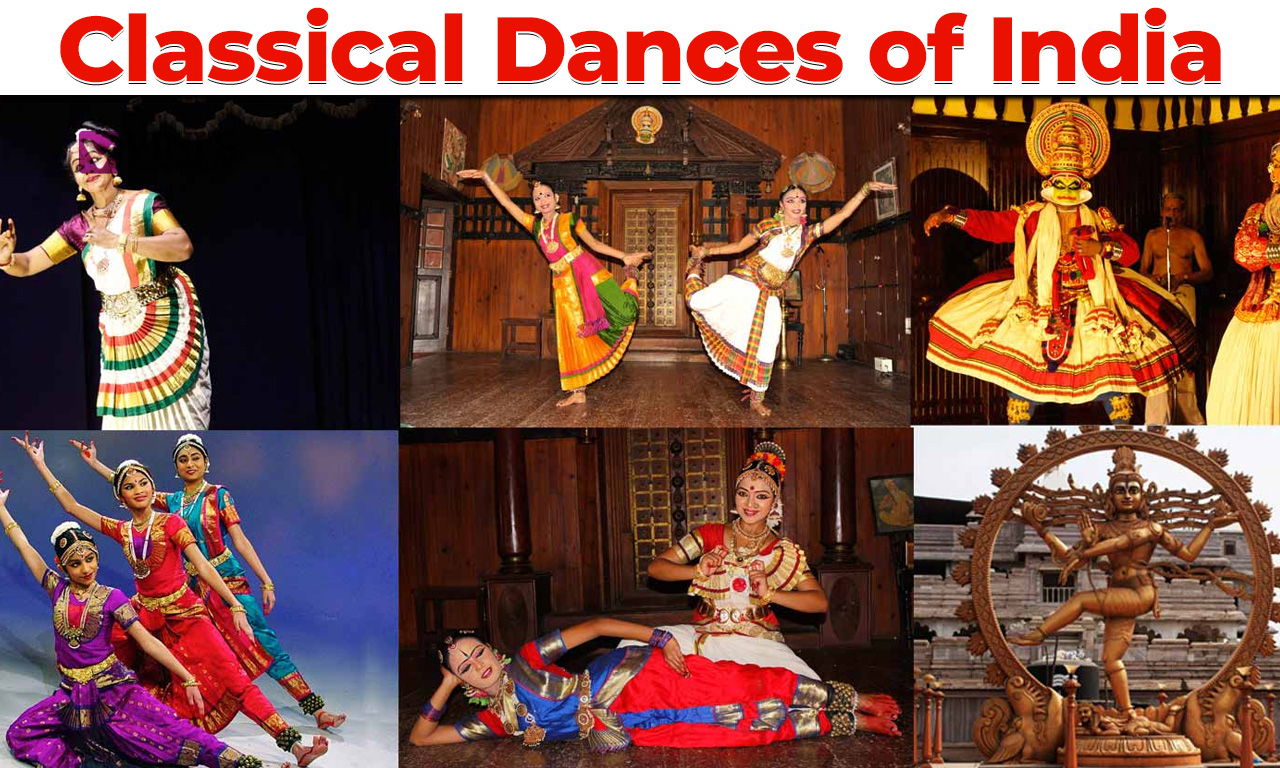Classical Dances of India:- India’s classical dances are a reflection of its profound cultural and artistic heritage, each form deeply rooted in ancient traditions. These dances are not merely performances but a blend of art, spirituality, and storytelling that have evolved over centuries. From the expressive Bharatanatyam of Tamil Nadu to the vibrant Kathak of North India, these forms encapsulate the essence of regional customs and religious beliefs. Together, they represent the country’s immense diversity, offering a glimpse into the rich and varied traditions that make up India’s cultural identity. Check out the list of Classical Dances of India from the below article.
Classical Dances of India 2024
Indian classical dance is a mesmerizing art form that has been cherished and passed down through generations, helping to keep our country’s vibrant cultural heritage alive. These dances combine fluid movements with expressive gestures, all rooted in age-old traditions and stories from mythology. Each style has its regional charm, reflecting the unique culture of different parts of India. With their beauty and storytelling, these dances never fail to captivate and inspire audiences. Check out the Classical Dances of India below.
List of Classical Dances of India
Classical dance is a traditional form of artistic expression that follows specific rules, techniques, and structured movements. Each region in India has developed its own distinct style, but all share a focus on storytelling, symbolism, and graceful movements.
Across the country, these dance forms have evolved uniquely while adhering to the core principles laid out in the Natya Shastra. According to this ancient text, only a guru, or master, is qualified to impart the knowledge of these art forms. The relationship between the teacher and student, known as the ‘guru-shishya parampara,’ is central to preserving and passing on the classical traditions. Currently, the Sangeet Natak Akademi recognizes nine classical dance styles that represent this rich heritage. Below are the 9 Classical Dances of India:-
| 9 Classical Dances of India | |
| Classical Dance Form | State of Origin |
| Bharatanatyam | Tamil Nadu |
| Kathak | Uttar Pradesh |
| Kathakali | Kerala |
| Odissi | Odisha |
| Manipuri | Manipur |
| Kuchipudi | Andhra Pradesh |
| Mohiniyattam | Kerala |
| Sattriya | Assam |
| Chhau | Orissa, Jharkhand, and West Bengal |
Classical Dances in India State-Wise
Check out the Classical Dances in India State-Wise below:-
| Classical Dance in India State-Wise | ||
| Dance Form | Location | Significance |
| Bharatanatyam | Tamil Nadu | An ekaharya dance genre where a single dancer represents numerous roles in a single performance. |
| Kuchipudi | Andhra Pradesh | Developed in the 17th century by Siddhendra Yogi, performed in groups as a dance play. |
| Kathakali | Kerala | Includes dance, music, and acting to dramatize tales from Indian epics. |
| Mohiniyattam | Kerala | Traditional solo dancing style of Kerala, mentioned in the book Vyavahara Mala in 1709. |
| Odissi | Odisha | Focuses on Lord Vishnu’s incarnations and passages from Jayadeva’s Gita Govinda. |
| Manipuri | Manipur | Rooted in prehistoric times, connected to rituals and festivals in Manipur. |
| Sattriya | Assam | Created by Vaishnava saint Sankaradeva in the 15th century A.D., connected to Sattras. |
| Kathak | Uttar Pradesh | Derived from “Katha,” meaning “a story,” evolved during the bhakti movement in the 15th century. |
| Chhau | Orissa, Jharkhand, and West Bengal | Tribal martial art dance found in Odisha, Jharkhand, and West Bengal. |
Interesting Facts of Classical Dances in India
- Ancient Origins: Indian classical dances date back over 2,000 years, rooted in the Natya Shastra, an ancient Sanskrit text that guides the art of dance, drama, and music.
- Storytelling Art: These dances are not just movements but intricate storytelling, using gestures, facial expressions, and body movements to narrate mythological and folkloric tales.
- Regional Diversity: Each classical dance style represents the unique culture of its region, such as Bharatanatyam from Tamil Nadu and Kathakali from Kerala, both distinct yet part of India’s diverse cultural fabric.
- Guru-Shishya Tradition: Classical dance training follows the guru-shishya parampara, where students learn from a master over years of dedication, ensuring the art form’s purity and continuity.
- Nine Recognized Forms: The Sangeet Natak Akademi recognizes nine classical dance forms: Bharatanatyam, Kathak, Kathakali, Kuchipudi, Odissi, Manipuri, Mohiniyattam, Sattriya, and Yakshagana.
- Intricate Costumes and Makeup: Dancers wear elaborate costumes and makeup that reflect the traditional and cultural essence of each dance form, enhancing the storytelling and visual impact.
- Hand Gestures and Expressions: Mudras (hand gestures) and abhinaya (facial expressions) are crucial elements in classical dance, with each gesture and expression carrying deep symbolic meanings.
- Spiritual Connection: Many classical dance forms, like Bharatanatyam and Odissi, are seen as offerings to the divine, blending spirituality and artistic expression.
- All-Night Performances: In traditional Kathakali performances, dancers depict epic tales such as the Mahabharata or Ramayana in all-night sessions, filled with drama and intense choreography.
- Global Recognition: Indian classical dances have gained international fame, with performances and training schools worldwide, ensuring the preservation and growth of these ancient art forms.
Also, check out the list of longest rivers in the world.











